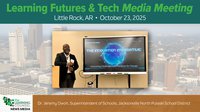A 40 percent jump in parent responses to conference scheduling. That’s what our district saw after introducing a new cloud-based phone system built right into our school-home communications platform we already use and trust to connect with families. In a world dominated by texts and emails, a simple phone call—when made easy and professional—remains one of the most effective ways to engage families.
Like many districts, we faced a growing challenge: families weren’t picking up calls from unknown numbers, and staff were using personal phones or patchwork systems to reach out. Without a unified approach, communication felt fragmented—leading to delays, frustration, and missed connections.
Using our communication company’s Virtual Phone enabled us to change that. It allowed staff to call from any device using a school-branded number, while protecting their privacy and automatically logging outreach. Now, we can see who has been contacted, follow up faster, and build stronger connections with families who were once hard to reach.
As a result, our staff is empowered with a professional, reliable way to reach families, building trust and improving communication. That trust has led to better outcomes, including increased staff confidence, improved student attendance, and better relationships with parents and caregivers. Virtual Phone is a vital part of our family engagement efforts—supporting meaningful communication while allowing staff to protect their privacy and maintain work-life balance.
Boosting Engagement and Efficiency
Since all calls go through our school-home communications platform, each user has a dedicated phone number with the school’s area code, so families actually recognize the caller ID and pick up, resulting in higher response rates. Plus, all calls are logged, and staff members can add notes about their conversations for easy reference—making communication more organized and efficient across the board.
Staff can dial any U.S.-based, 10-digit number, sync calls across devices for easy reference, set office hours to send calls to voicemail after hours, and block unwanted calls.
Here are five more benefits we’ve discovered since implementing this tool:
- Families feel more connected. It’s transformed how we connect, fostering a more cohesive school community. Not only has the solution boosted engagement and efficiency, but it’s helped families feel more connected to their child’s education while saving staff time with streamlined communication. One standout example is our Family Check-In initiative, where teachers call parents to discuss student progress and goals. For many families, these conversations were a new and welcomed experience. By enabling meaningful, one-on-one connections, the solution helps us build a more engaged and supportive school community, ultimately leading to better student outcomes.
- Staff are more confident. An unexpected benefit has been the increase in staff confidence. Without the worry of sharing personal numbers, staff have a private and professional way to connect with families, leading to more proactive outreach. They can also add notes and choose from a list of predefined call reasons and have their calls automatically transcribed (if needed).
- Accountability is easier than ever. Accountability has improved thanks to logged interactions and in-app notifications for missed calls and voicemails—ensuring no call or message goes unanswered. This helps us build a more responsive and connected community.
- Attendance follow-ups can be more personal. We now have a tool for attendance follow-ups. For example, a parent who had been unresponsive to email and paper notices answered a call from their child’s teacher. The conversation revealed the family was experiencing transportation issues, which we were able to quickly resolve. This is just one example of how a quick, personal phone call can improve attendance and strengthen trust in our district.
- Decisions are data-informed. Since the solution syncs directly with our student information system (SIS), it provides real-time visibility into data. This allows us to monitor data quality and proactively address issues like missing or inaccurate information. With accurate data and actionable insights, schools can better identify where targeted strategies are needed and use Virtual Phone to conduct outreach to families.
By taking a modern approach to the familiar phone call and integrating it into our communication platform, we’ve reduced confusion, saved time, and streamlined outreach. Most importantly, we’ve strengthened the connections that matter most—between schools and families.
About the author
Gary Lambert is the director of IT, communications and security at Beekmantown Central School District in West Chazy, NY.











